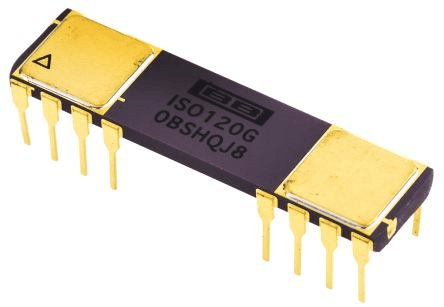Isolation Amplifiers Information
 Isolation amplifiers electrically isolate input and output signals, often by inductive couplings. Isolation amplifiers, or iso-amps, may be used to protect components from potentially dangerous voltages or to amplify low-level analog signals in applications with multiple channels. Isolation amplifiers work with systems where a sensor or input is separated from the system supplying data. These isolation barriers are useful in protecting sensitive sensors from high voltages. A good example of this type of amplifier isolation exists in medical devices that use electricity to get physical data from patients, such as an electrocardiograph (ECG) or an electroencephalograph (EEG).
Isolation amplifiers electrically isolate input and output signals, often by inductive couplings. Isolation amplifiers, or iso-amps, may be used to protect components from potentially dangerous voltages or to amplify low-level analog signals in applications with multiple channels. Isolation amplifiers work with systems where a sensor or input is separated from the system supplying data. These isolation barriers are useful in protecting sensitive sensors from high voltages. A good example of this type of amplifier isolation exists in medical devices that use electricity to get physical data from patients, such as an electrocardiograph (ECG) or an electroencephalograph (EEG).
Features
Performance criteria for isolation amplifiers includes:
- supply voltage
- supply current
- operating temperature
The supply voltage in isolation amplifiers refers to the source of the voltage range. Supply current is the current that is produced by the supply source when it’s connected to an isolation amplifier. The operating temperature in isolation amplifiers is the specified value of ambient temperature that the amplifier was designed to operate.
Isolation amplifiers use a variety of techniques to minimize large-signal nonlinearity and distortion. These techniques include using a linear optocoupler (LOC) to increase the linearity of the isolation amplifier over a particular signal range. Linear optocouplers (LOC) consist of an input light emitting diode (LED) coupled to two photodiodes. One photodiode is used to feed the input circuitry and the other photodiode is used to feed the output circuitry. Another challenge when designing an iso-amp is the task of minimizing signal drift. Often, when an isolation amplifier heats up during operation, the current along the circuit decreases. Isolation amplifiers are typically compared by cost, size, and performance as the main criteria, with the technical requirements being linearity, stability of signal, and high frequency response. Other concerns when purchasing or building an isolation amplifier include managing leakage and breakdown voltage.
Applications
Isolation amplifiers are frequently used in signal conditioning applications. Signal conditioning may use a variety of different bipolar, complementary bipolar, and complementary metal oxide semiconductor (CMOS) amplifiers, including instrumentation amplifiers, chopper amplifiers, or isolation amplifiers. Since many devices operate from batteries or low-power sources, choosing an isolation amplifier for a signal conditioning application involves considering the amplifier’s supply voltage characteristics.
Related Information
Electronics360—Isolated Current Sense Amplifier Targets Industrial Motor Drives and Inverters
Electronics360—Understand Current-Sensing Techniques and Challenges
Electronics360—Analog Chip Vendors Target Growing Market in Electrocardiograms
